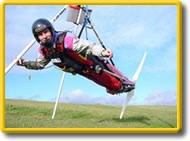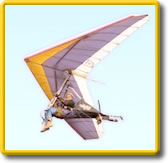 With the relaxation of regulations governing Foot Launch Power Assisted (FLPA) hang gliders it is now possible to own a powered aircraft without expensive hangarage, registration, license and annual permit fees. Powered Hang Gliding is a de-regulated activity and requires an endorsement by the BHPA or BMMA.
With the relaxation of regulations governing Foot Launch Power Assisted (FLPA) hang gliders it is now possible to own a powered aircraft without expensive hangarage, registration, license and annual permit fees. Powered Hang Gliding is a de-regulated activity and requires an endorsement by the BHPA or BMMA.
The Doodlebug Hang Gliding Power Unit
The power unit fits onto most hang glider wings transforming them into a motorised glider that frees you from the constraints of a hill, winch or aerotow. Once the engine is switched off the performance of the hang glider is little affected thanks to the sleek design of the unit.
The unit has a spacious stowage area behind the pilot allowing you to store a glider bag, sleeping bag or a light weight tent. Coupled with very easy ground handling for this type of machine, it makes for a realistic bivouac tourer.
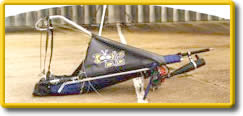 The Doodlebug is simple to launch, requiring only a few steps. In a light breeze it becomes airborne in less than 25 meters in calm conditions. After launch the pilot sits back into the seat and moves their legs forward through the control frame. The support legs are then retracted by pulling down the overhead foot stirrup and pushing the stirrup out to support the pilot’s feet. This automatically retracts the legs along side the fuselage.
The Doodlebug is simple to launch, requiring only a few steps. In a light breeze it becomes airborne in less than 25 meters in calm conditions. After launch the pilot sits back into the seat and moves their legs forward through the control frame. The support legs are then retracted by pulling down the overhead foot stirrup and pushing the stirrup out to support the pilot’s feet. This automatically retracts the legs along side the fuselage.
The Doodlebug is a true retractable undercarriage aircraft weighing less than 60 kilos. Controls are typical to the wing that the unit is attached to with no adverse effects to the flying controls. The side cords of the unit stop any unwanted lateral movement of the engine, preventing powered spiral instability which causes tightening into turns. Other units tend to suffer this and can be observed weaving on climb out. You can fly hands off in a climb with the Doodlebug.
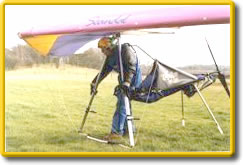 Landing the Doodlebug is probably one of the easiest things about the unit. The pilot releases the foot stirrup which allows the legs to swing back ready for landing. After bringing their feet back behind the control bar they then rotate out of the seat and adopt the upright position commonly known as the “Gorilla Position”. The landing approach is made similar to a normal hang glider with a little additional speed to allow for the extra weight of the unit. After rotation the unit’s legs start to drag on the ground and the pilot gently flares the wing to produce a perfect 2 or 3 step landing. The drag from the legs eliminates the need for an aggressive flare.
Landing the Doodlebug is probably one of the easiest things about the unit. The pilot releases the foot stirrup which allows the legs to swing back ready for landing. After bringing their feet back behind the control bar they then rotate out of the seat and adopt the upright position commonly known as the “Gorilla Position”. The landing approach is made similar to a normal hang glider with a little additional speed to allow for the extra weight of the unit. After rotation the unit’s legs start to drag on the ground and the pilot gently flares the wing to produce a perfect 2 or 3 step landing. The drag from the legs eliminates the need for an aggressive flare.
Doodlebug Performance Data
Weight : 21 Kilos
Engine: Radne Raket 120 cc
Power: 14 Bhp at 9000 rpm
Fuel Capacity: 10 Litres
Flight Duration using power: 4 – 5 hours
Set up Time including wing rigging: 20 minutes
Climb rate: 350/400 feet per min
Three models available.
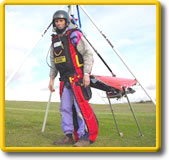 Booster – From Pegasus Aviation
Booster – From Pegasus Aviation
A recent addition to the power hang gliding world comes from Pegasus Aviation, in the guise of their ‘Booster’ power unit. Weighing in at only 25 kilos, the unit has a folding prop which adds greater stability in turns due to a reduced yawing effect on the blades. Wheels are fitted to the skids to allow more efficient use of thrust in the take off run. This is especially useful when taking off at high altitude when all available thrust is required.
Your own harness can be modified in an inexpensive way to allow you to fly with the ‘Booster’.
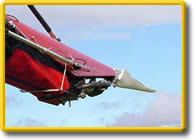 Engine noise has been reduced from 102db to 94db with the introduction of both after muffler and air intake. This is at a cost of an extra kilo weight but at no loss in power. Power output at 8.6 thousand revs =30 kilos/ 8.8hp of thrust and there are plans to gear the unit to rev at 9.5 thousand revs to give 40 kilos/ 10.2hp of thrust
Engine noise has been reduced from 102db to 94db with the introduction of both after muffler and air intake. This is at a cost of an extra kilo weight but at no loss in power. Power output at 8.6 thousand revs =30 kilos/ 8.8hp of thrust and there are plans to gear the unit to rev at 9.5 thousand revs to give 40 kilos/ 10.2hp of thrust